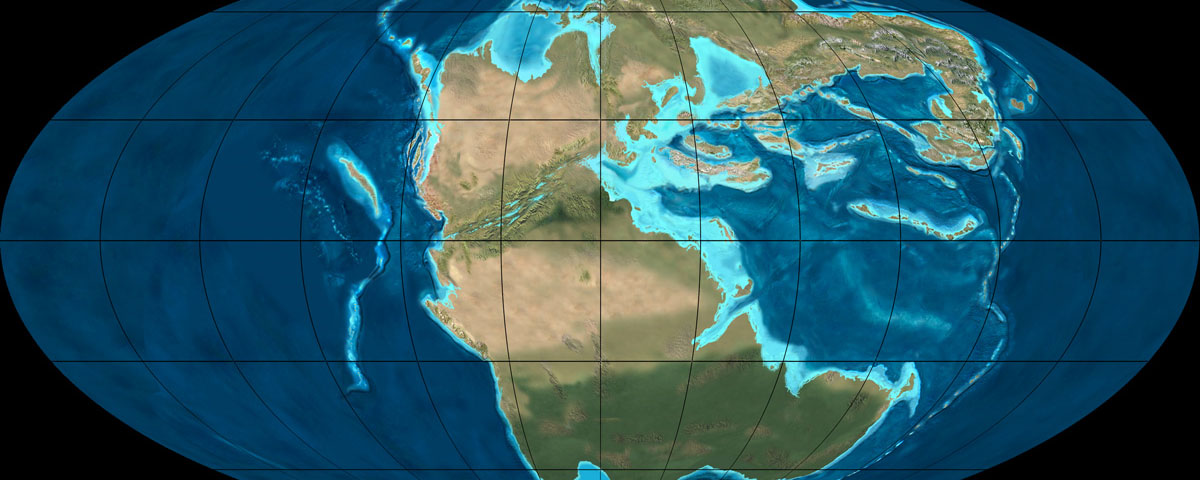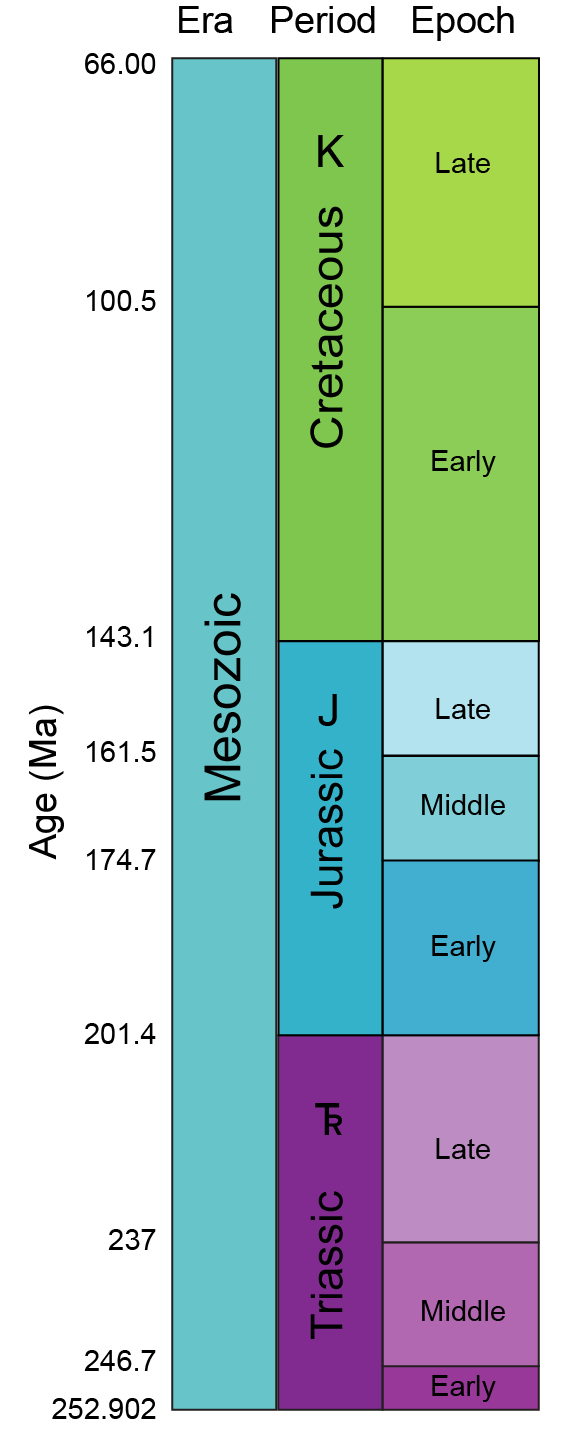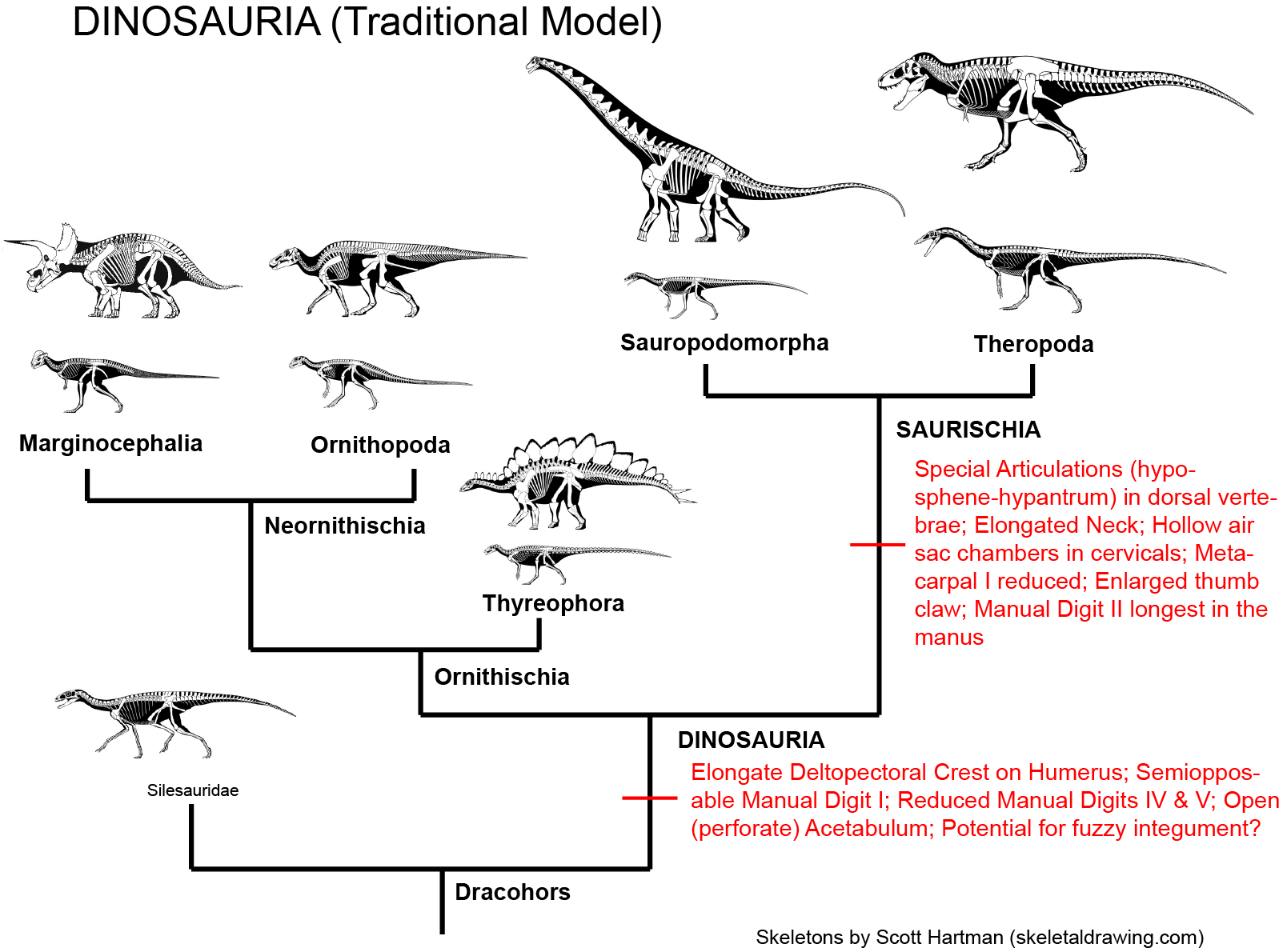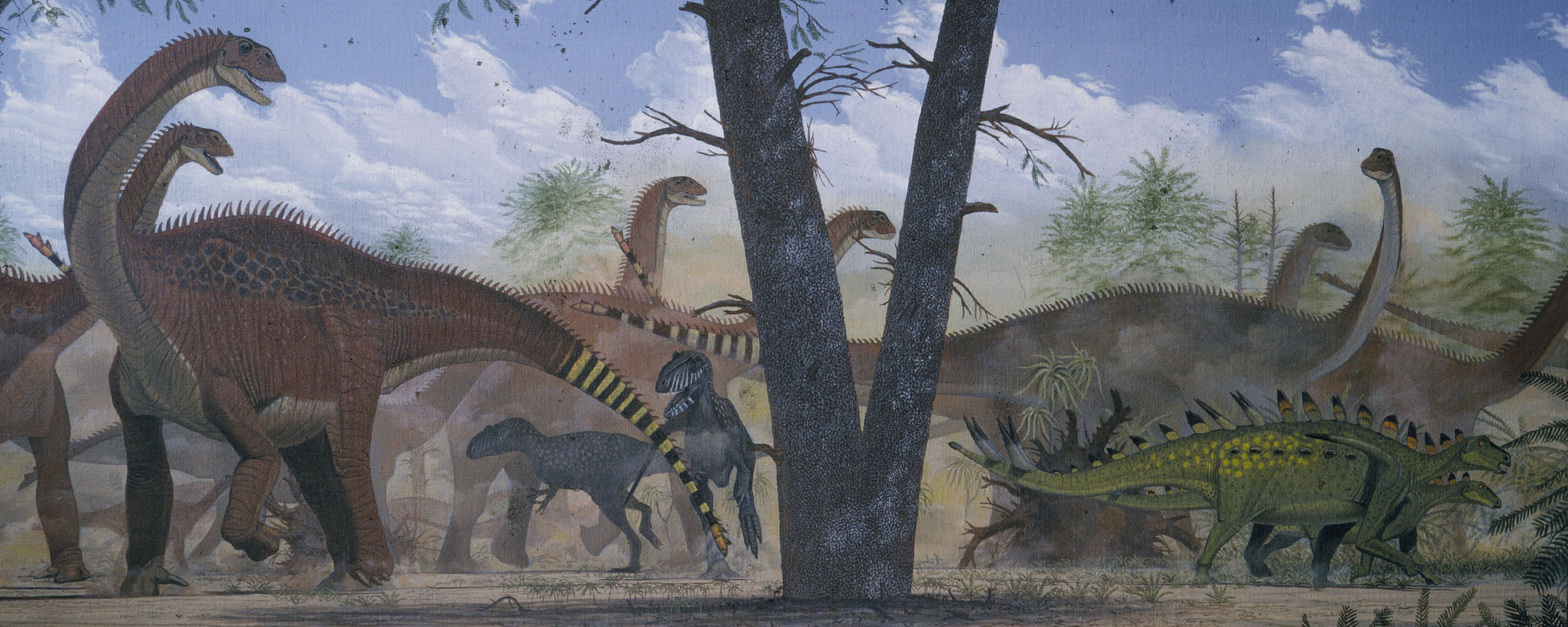



Phanerozoic Eon: 538.8 - 0 Ma
| Period | Range (Ma) |
|---|---|
| Cretaceous | 143.1 - 66.00 |
| Jurassic | 201.4 - 143.1 |
| Triassic | 251.902 - 201.4 |
Paleogeography and Geology of the Triassic:
The Sonoman Orogeny is still underway (collision of Sonomia and western North America).
Abundant redbeds in many parts of the world.(New Red Sandstone in Britain; Karoo Supergroup (actually a Permo-Jurassic unit) in southern Africa; Moenkopi through Chinle Formation in southwestern U.S., etc.). Once thought to indicate worldwide dry conditions, but now seen as product of a couple of other factors:
Collision of North and South China blocks with Siberian coast completes Pangaea.
Appalachians and other mid-Pangaean mountains worn down until low ridge.
During latest Triassic: rifting in mid-Pangaea (between North America + Europe and Africa).
Paleogeography and Geology of the Jurassic:
Continued rifting and volcanism along Central Atlantic margin (including the Palisades of New York, New Jersey, and southern New England); the Newark Supergroup development continues. Extensive evaporite deposits.
Continued evidence of arid conditions in many parts of the world during the Early Jurassic (Glen Canyon Group of American Southwest, etc.).
During Middle Jurassic, major global transgressions and return to calcite sea conditions. Europe flooded, development of European Archipelago.
As Atlantic grows:
In Middle-Late Jurassic, development of ongoing "Andean"-style subduction along Pacific coastline of North America. Foreland periodically flooded and emergent.
During Late Jurassic, Nevadan Orogeny:
In earliest Triassic seas: return of stromatolites to shallow subtidal environments (perhaps grazers were so reduced that for a time they flourished).
Temperatures at the equator are exceptionally (lethally) hot in the sea, and possibly land, during the first million years of so the Triassic.
Major adaptive radiation of groups begins: ammonoids up to 100 genera by end of the Early Triassic. Ammonoids are amazingly abundant throughout the Mesozoic.
Early Triassic seas dominated by bivalves, gastropods, ammonoids, some articulate brachiopods, and sea urchins (echinoids): the Modern Evolutionary fauna displaces the Paleozoic Evolutionary Fauna.
During Middle Triassic: return of reefs, built by a new group: scleractinian corals (or hexacorals).
Sharks diversify, including shellfish-eaters. Ray-finned fish radiate: most in Triassic have heavy armored scales.
Marine reptiles arise: most of the Triassic forms (thallatosaurs, placodonts, nothosaurs, pachypleurosaurs, etc.) are near-shore animals, but two pelagic clades also appear:
Terminal Triassic extinction event: wipes out last of the conodonts, many marine reptiles (other than ichthyosaurs and plesiosaurs), many species of bivalve and ammonoid.
Marine Life in the Jurassic:
Radiation of the dinoflagellates.
Origin of the coccolithophorids (chalk-makers).
Origin of the coiled oysters (soft sediment-dwelling oysters).
Radiation of belemnoids (internally-armored cephalopods, originated in later Paleozoic).
First skates and rays (flattened, bottom-dwelling sharks).
Radiation of the teleosts (advanced ray-finned fish with extrusible jaws: almost all living ray-fins are teleosts). Some reach 12 m or more: first giant plankton-gulping vertebrates (although the biggest placoderm was probably a plankton gulper, too.
Marine crocodilians appear in Early Jurassic. Heyday of the ichthyosaurs; high diversity of plesiosaurs (including forms over 14 m long!!).
All but ferns are "gymnosperms": seed plants with indirect fertilization. It is possible that by the Middle/Late Jurassic boundary the angiosperms (flowering & fruiting plants) had evolved. But the Jurassic specimens are currently controversial, and they are definitely not an important part of the ecosystem until the Cretaceous, so we will wait until that Period to discuss them.
Mammals and their Ancestors
In Early Triassic, advanced therapsids remain the dominant group. However, rising in diversity are various groups of sauropsids (reptiles).
Early Triassic therapsids included large bodied herbivores and smaller carnivores and omnivores. Evidence from an enlarged centralized opening in the snout suggests at least some of these were whiskered.
Mammals and their closest relatives (more properly Mammaliformes, or sometimes "Mammaliaformes") appear in fossil record the same time as dinosaurs, in Late Triassic.
Mammals are very advanced therapsids synapsids.
True mammals (Mammalia) found from Middle Jurassic onward.
Like birds, many of the features that characterize modern mammals don't fossilize:
On the other hand, some mammalian features are preservable:
Many features limited to Mammalia among living amniotes were probably found in their closest non-mammalian therapsids relatives. For example, we can't say for certain when warm-blood, fur, sweat & mammary glands show up. We can determine a few of these, though:
Living mammals are divided into three clades:
However, mammal diversity in the Mesozoic was MUCH different. Many groups of Mesozoic mammals have long since died out. And some Mesozoic mammal groups survived the end of the Cretaceous, but have since died out.
Most Mesozoic mammals very small (shrew-to-house cat sized, with a few badger-sized forms in the Cretaceous); mammals only become large AFTER extinction of non-avian dinosaurs.
Oldest mammaliforms of the Late Triassic and Early Jurassic were fairly small. But by Middle and Late Jurassic, there were already some specialized mammals:
Sauropsids
In Early Triassic, advanced therapsids remain the dominant group. However, rising in diversity are the diapsids (sauropsids with a pair of openings behind the eye for jaw muscles, and long hind legs allowing them to shift from quadrupedal to bipedal mode when speed is needed)
In the Middle and Late Triassic, massive radiation of diapsids into:
Among the most successful branch are the archosaurs (diapsids with an extra opening between the eyesocket and the nostril, possibly housing soft tissue associated with cooling the face, and an advanced breathing system).
In the Middle and Late Triassic, archosaurs dominate most terrestrial ecosystems, the archosaurs displaced the therapsids as the dominant group of large terrestrial amniotes.
Archosaurs are divided into two main branches:
It is the pseudosuchians which dominated the Middle and Late Triassic. This group radiated into a number of forms:
The pseudosuchians include some of the first terrestrial animals to exceed the size of oxen and hippos. Most of them could stand with a semi-erect posture of the limbs, and a few had the fully-erect (that is, parasagittal gait).
Although pseudosuchians may have been the dominant group, plenty of other forms abounded in the Middle and Late Triassic. These included the last of the big beaked therapsid herbivores; more advanced, but generally small therapsids (including the oldest mammals: more about them later); many non-archosaurian diapsids (see above); and...
The First DINOSAURS! Dinosaurs and their closest relatives and ancestors (together, the dinosauromorphs) are notable in their hindlimbs:
The combination of these traits allowed the little dinosauromorphs to run and accelerate in a bipedal mode all the time, not just at top speeds like typical diapsids. (It is not yet certain if the earliest dinosauromorphs such as Marasuchus were primarily quadrupeds or bipedal.
The parasagittal gait and hinge-like ankle also allowed dinosauromorphs the ability to move more actively and constantly rather than only in short bursts of speeds; thus, they were striders. Additionally, although early dinosauromorphs were small (~30 cm long for Marasuchus, 1-2 m long for silesaurs and basal dinosaurs, etc.), the presence of limbs directly underneath the body meant that this lineage to grow to much larger size than any previous clade while still remaining terrestrial and mobile (sprawlers relegated to a semi-aquatic life if they became too big to support their weight).
The first true dinosaurs are known from fossils around 228 Ma (the very beginning of the Late Triassic), and so the group as a whole probably first evolved slightly earlier (in the Middle Triassic). Early dinosaurs were all small (1-2 m long), bipedal (walked on their hind legs), and had grasping hands.
From the first dinosaurs evolved many different branches:

These branches included:
Among the diversity of small dinosaurs were some that evolved a covering of fur-like hollow structures. These protofeathers were probably originally for insulation, but became adapted by more specialized forms into true feathers. There were many lineages of feathered dinosaurs, one of which includes modern birds and their Mesozoic ancestors. Birds are therefore a group of dinosaurs: they are descendants of the most recent common ancestor of Iguanodon Diplodocus, and Megalosaurus. Bird radiation continued throughout Cretaceous, with many groups of sea birds and land birds
Dinosaurs hatched from eggs, and even the largest dinosaurs grew from babies that could fit in an egg the size of a soccer ball. Recent studies show that it took big dinosaurs only 7 to 20 years to reach full size! This, along with many other lines of evidence, suggests that dinosaurs had active metabolisms, more like mammals (and modern birds) than like lizards and crocodilians:
During the Triassic-Jurassic Extinction, many victims on land:
During the Jurassic, diversification among most surviving land vertebrates. Origin of first pterodactyloids (advanced specialized short-tailed pterosaurs)
However, most important diversifications occur in dinosaurs. Truly large dinosaurs, big armored dinosaurs, powerful carnivores, all appear at this time. Dinosaur groups rose, diversified, and went extinct throughout the Mesozoic. Remained the dominant group of terrestrial vertebrates until the end of the Cretaceous.
For more information, take GEOL 104 Dinosaurs: A Natural History, Fall Semester.
Why Triassic Reptiles were Just the Weirdest:
The Time It Rained for Two Million Years (The Carnian Pluvial Episode):
When the Atlantic Ripped Open A Supercontinent:
How Did Dinosaurs Get So Huge?
The Facts About Dinosaurs & Feathers
How The Turtle Got Its Shell:
To Lecture Notes.
